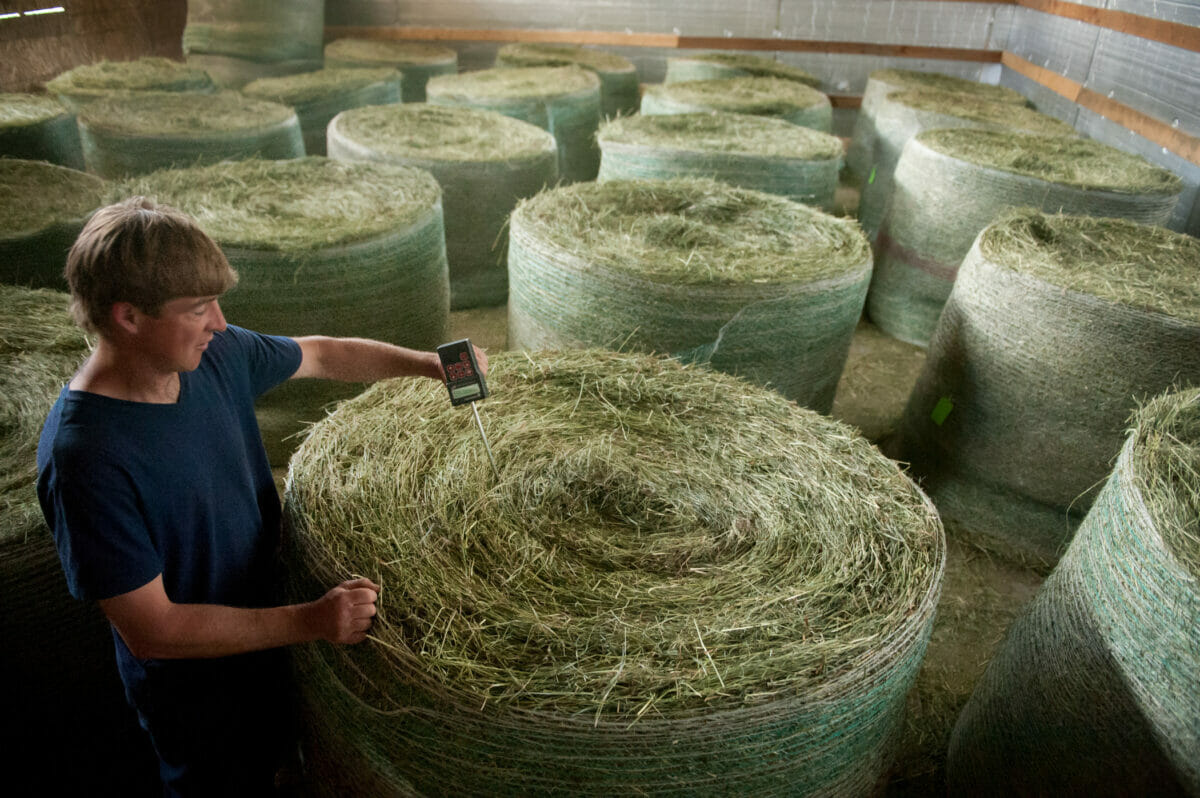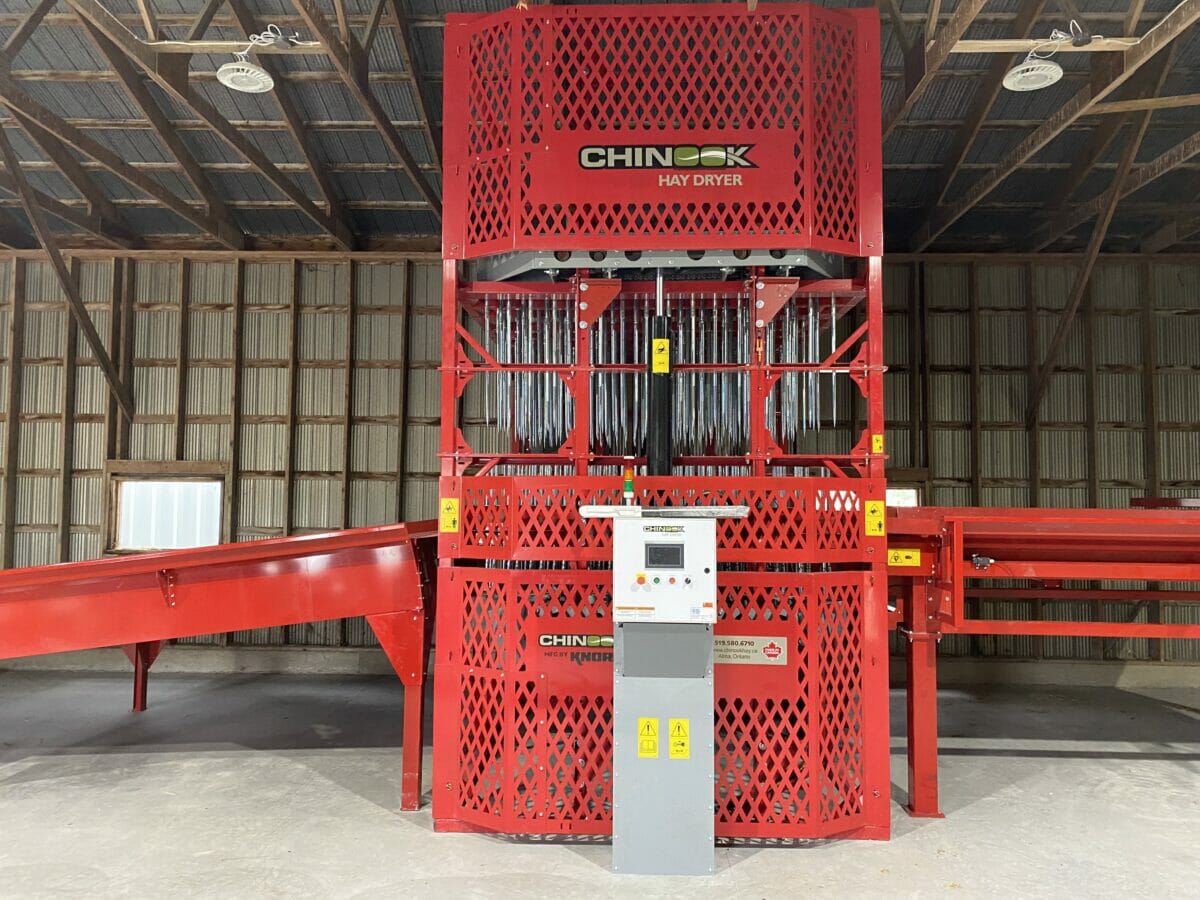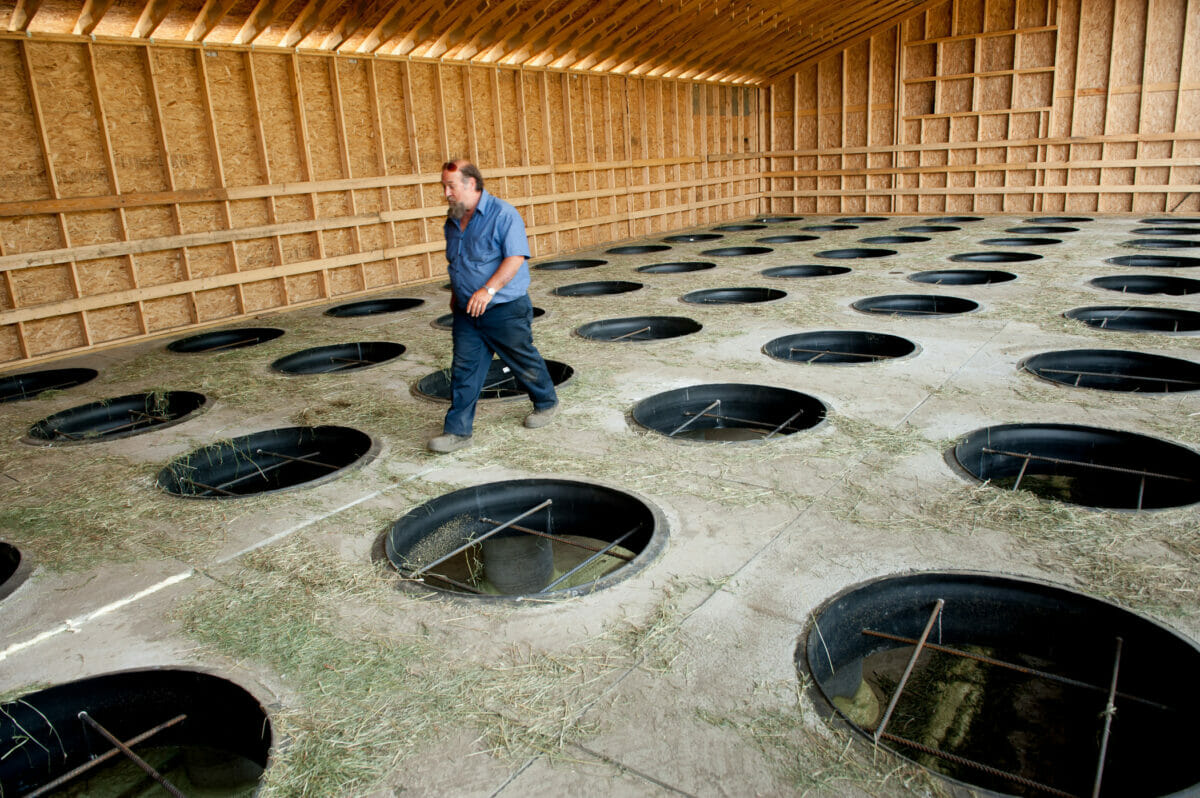Although hay dryers are a staple throughout Europe, they are few and far between on US farms. But as climate change intensifies, that's changing.

Nestled along the banks of the Portage River in Pemberville, Ohio, John Russell has spent more than 20 years working as a commercial hay producer. From a season that typically spans May through October, he has long relied on an arsenal of hay bines, conditioning rolls, rakes and tedders to produce 500 to 600 acres of dry hay each year. He has also made regular upgrades to drainage lines on his farm to ensure his crop is as dry as possible before being sold and pitched into bundles.
In recent years, however, unpredictable weather patterns and relentless rain have repeatedly left his fields saturated, putting him at risk of falling weeks behind in hay production. Russell says his usual equipment wasn’t cutting it anymore, so last winter in 2020, he decided to buy a hay dryer.
“I’ve always thought of [hay dryers] as a last resort, but I really felt like we had been doing all that we could,” he says. “This will get you out of a bind, when the forecast changes if you think you’re going to lose a day. It will allow you to beat the rain.”
His machine consists of a metal chamber that houses 63 hay bales at their individual sizes of 14x18x36 inches. In the drying cavity, each bale is punctured with spikes that shoot out hot air. According to Russell, it has the ability to dry them in 15 to 20 minutes. That’s way faster than drying out only in the field, which can take anywhere from one to five days depending on the sun and environmental conditions.

John Russell’s hay dryer.
His machine, which he purchased in Canada, was about $225,000. In general, they carry a price tag of around $220,000 to $300,000 depending on the manufacturer, but Russell figures he’s been able to earn back his investment by speeding up production and moving through the blips in weather.
Despite making a case for hay dryers’ effectiveness, the Ohio farmer is only part of a handful of producers across the country using the machines. It’s a stark contrast to Europe, where they’re considered a widespread fixture in the world of haymaking and feed production, specifically on dairy farms.
Experts in agriculture claim the disparity comes down to affordability and differing attitudes around food. European farmers are subsidized by the EU, which provides around $65 billion each year to support farmers during turbulent years, possibly making it easier for them to offset the costs of a hay dryer. But with climate change already affecting various aspects of agriculture, experts believe there’s potential for the technology to gain popularity in other countries, including the US.
Joe Lawrence, a forage systems specialist at Cornell University’s College of Agriculture and Life Sciences, says he’s only seen larger commercial hay producers invest in hay dryers because it’s typically not financially feasible, especially for smaller operations.
“Any time I’ve talked to a US producer that has considered [hay dryers] or tried, I’m hearing it’s a very energy-intensive process,” he says. “Some of these things have large diesel engines and, if you have to pay the market rates for energy, whether it’s electricity or natural gas or whatever your source is, it’s going to add quite a bit of cost unless you can get a pretty substantial return.”
But for farmers grappling with weather changes in their region, Lawrence doesn’t rule out the possibility of increased demand for dryers. He forecasts a future where unpredictable and more severe weather will be of greater inconvenience, but he says he could also see some producers switching to silage to cope.
Those embedded in the European market argue that the cost of the machines is offset by the fact that you’re producing a higher-quality product with them. Sabine Zastrow’s family has been manufacturing hay dryers since the 1970s for farms across the EU. Currently, under its Germany-based company AgriCompact Technologies, the family has more than 1,000 customers in Europe but only two in the United States. She believes the lack of machines in the US comes down to there not being as many producers who subscribe to the Slow Food movement, which promotes local food cultures and traditions, or understand the benefit of dry hay feed without preservatives.
“In Europe, we have and live by the philosophy of ‘you are what you eat.’ If the animal is not fed or treated well, how can you, as a human being, be well fed?” she says. “The animals and what you feed them, it’s all connected, like a circle—it comes back around for you. The food tastes better because the animals are happy and healthy.”
Zastrow notes that in the EU there’s been a history of banning additives in animal feed throughout the agriculture sector and some name protection regulations for European cheeses, such as Parmigiano-Reggiano, prohibit fermented feeds. In a nutshell, she says, a diet of dry hay without preservatives is thought of as the healthiest type of forage and a clear indicator of a top-quality product, especially when the milk is unpasteurized.
In comparison to silage diets and distillers grains, studies have pointed to dry hay’s potential to reduce the presence of harmful bacteria, such as listeria, in raw milk. So the hay dryers not only help producers keep up with Europe’s demand for dry hay, but they also help eliminate moisture where mold and other bacteria can put an animal’s—and potentially a human’s—health at risk.
This is a philosophy to which Jasper Hill Farm also subscribes. The dairy farm and creamery in Greensboro, Vermont feeds its cows a dry hay diet with corn and grain that is free of GMOs and ferments. In 2015, after visiting a number of producers in Europe to understand regional processes around making artisan cheese with raw milk, Jasper Hill installed its hay dryer. Its model differs to Russell’s in design. It consists of a floor with holes for 50 bales in which to sit. Under the floor, there’s a vacuum of space where an adjacent furnace powers up turbines that blow 104-degree air up through the bales over several hours.

Jasper Hill Farm’s hay dryer.
The farm’s crop manager, Ellie Searles, says the dryer ensures the animals a clean, dry hay diet, making it possible for Jasper Hill’s cheeses to compete with the quality of various European alpine cheeses that have historically been celebrated.
“You have even more control over the microbial profile of the cheese, which can make or break taste, texture, quality and appearance,” she says, adding that the microbial content of the cheese is regularly screened. “You’re able to take the extra step to eliminate moisture and bacteria that could be harmful for the animals and consumers, but don’t risk complicating the microbial environment of the cellars where we store a lot of inventory.”
Like Russell, she’s noticed the machines have become an important management tool as farmers grapple with heavy waves of humidity due to recent wildfires and hurricanes, in addition to the regular rain patterns that start and cap off the haying season in Vermont. She believes hay dryers could become an important part of farms’ futures, including those that operate outside the specialty cheese market.
Russell, meanwhile, knows that he’s fortunate to be in the position where he can afford a hay dryer. But in order for these machines to become more popular, there needs to be a variety of models for small and big producers at a price that is reasonable because, he says, at the end of the day, the first priority is knowing you are able to make ends meet.
Hay dryers are out of keeping with the Slow Food philosophy if they require the use of fossil fuels. Where frequent rains keep hay from drying naturally, perhaps it would be better to improve the method of making silage?
Out here in dry Utah, Staheli West makes hay steamers in order to keep the moisture content consistent.
Hay drying seems like something that could be accomplished using solar thermal and/or the “waste” heat from making biochar. Some electricity might be needed to move the hot air, but far less than other wise. Photovoltaics or generators fueled with charcoal gasification could eliminate all fossil fuel use from the process. The heat from the generator exhaust could be captured for drying. The solar hay drying system could also dry woodchips for making charcoal. The char could be added to the soil, live stock feed, and bedding, as well as fueling generators. The process heat produced during the char making… Read more »
In the third paragraph from the end, ““You’re able to take the extra step to eliminate moisture and bacteria that could be harmful for the animals and consumers, but risk complicating the microbial environment of the cellars where we store a lot of inventory.”
Is Searles providing a negative aspect of the dryer? It isn’t clear.
So as a horse owner how much does the dryer and cost of fuel to dry the hay increase the cost of a bale of hay? I know that will be passed on to the consumer… Cost of Hay has steadily increased over the years. Excusses given have been cost of fuel, fertilizer, drought, etc. But even in a good year it never goes back down…
Dryers would be useless in Colorado. Most days even with a light rain it’s dry enough to put hay up in three days. Very seldom is there a issue other than it getting to dry and then you loose all the leaf depending on what your putting up.
Nice concept, but the price and price of energy may remain an issue. Noticed all the bales were big and round. We had only the small squarish bales, easier to handle and stack without machinery. Would also say the conditions in Vermont aren’t the same nationwide. Bet alfalfa dries quickly outside in the Midwest or the Southwest.
My ranch
Do you think a large clear span hoop house could be a more affordable alternative, yes slower, but no fossil fuels needed ?
How does comparison to the cost of the Heil dryers of the 1060s. Cost of operation?